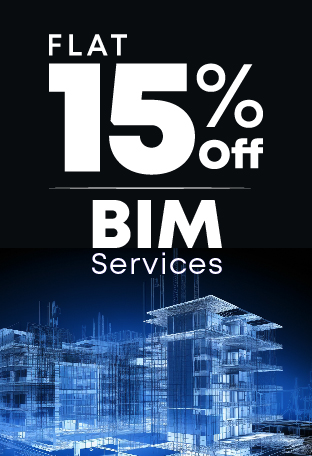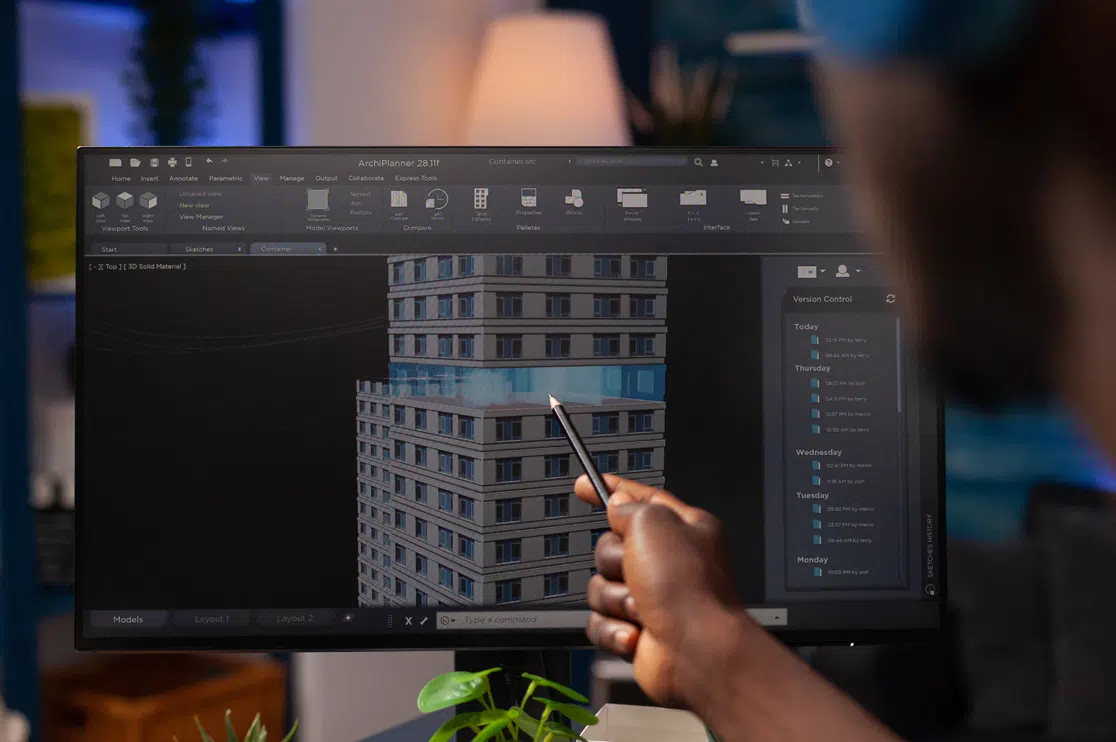BOQ, quantification, and cost estimation and so on.
1910! A solid 99 years to the present, Henry Laurence Gantt, an American mechanical engineer designed a chart popularly called Gantt chart, named after him, to monitor progress of the project against time constraint.
It has long been a popular technique for project planning. But it lacks something to be desired when it comes to visualizing a project timeline. 4D model is the solution to it. 4D model is a 3D CAD model attached to the fourth dimension of time via a schedule. Though the concept of 4D scheduling has been around over 20 years, it has not been popular due to some technical challenges associated with it.
The continuous advancement in technology and the emergence of Building Information Modeling (BIM) have removed all challenges associated with 4D scheduling. With the increasing success of BIM in the realm of designs, the adoption of 4D modeling is becoming the norm today.
Rich with information, BIM modeling services deliver architects a wealth of design-centric tasks and home builders a number of significant benefits including increased coordination, constructability analysis, BOQ, quantification, and cost estimation and so on.
One of the most important developments in building applications for BIM is the project planning where design and construction come together. At the core of a project planning, there lies building design, the backbone of a project planning. 4D scheduling plays an important role in project planning.
It includes vital data such as start and finish date of each component and their criticality. 4D model delivers minute details to the project team.
It works as a platform for project team and other non-technical stakeholders to visualize the assembling of a building over time. With 4D construction simulation process, architects can evaluate various options and choose the best alternative at project design phase.
Benefits of 4D Scheduling with BIM Platform
The benefits of 4D models based on BIM platform can be measured in two categories: (1) Tangible Benefits, and (2) Intangible Benefits. While the savings in cost and time, risk mitigation, conflict detection, reduction of complaints, improved productivity and enhanced quality are tangible benefits, a significant intangible gain seems to be in using the 4D models to communicate project parameters visually to home building owners (in case of Architecture Industry) and stakeholders (in case of Engineering Industry).
- Tangible Benefits: Savings in Cost and Time, Risk Mitigation, Conflict Detection, Reduction of Complaints, Improved Productivity, Enhanced Quality, etc.
- Intangible Benefits: Improved Communication among Various Division
- Communicate project parameters visually to non-technical stake holders and get their buy-in.
4D Modeling Offers Significant Benefits over 3D Modeling: 4D model is a further development over 3D model. It challenges and changes many of the practices of conventional scheduling. Some of the significant considerations are as follows:
Visualization of the Project: 4D model enables the scheduler to view the entire construction site in a nutshell. The scheduler is able to move around, look outside, inside and under the building and verify the progress of project. It helps the scheduler to detect inconsistency and avoid visual incongruities in the representation.
Better Integration and Cost Estimation: Integrating human resources, equipment and material resources with the BIM model, 4D scheduling helps to better schedule and cost estimate of the project. 4D BIM also monitors procurement status of project materials.
Conflict Detection and Resolution: During design and construction phase, potential spatial conflicts may arise between building components. It is not easy to identify or predict these conflicts using 2D or 3D layouts. But, 4D model identifies various issues related to space, schedule and sequencing, and resolve them ahead of the construction process.
Improved Time Management: Integrated with BIM modeling, 4D scheduling helps the owner as well as project team to easily visualize time constraints and opportunities of improvement and investment in the project.
Maximization of Critical Resources: 4D model allows the project team to evaluate various alternatives resources and scopes of work over a period of time to optimize the resources and labor accordingly.
4D Project Planning with BIM
By adding the schedule date to the model components, project team improves the plan and integrates the communication among various divisions. With the progress of time, project team programmatically links schedule to BIM model to evaluate various construction options to make the optimum decision. There are two methods for linking a BIM model to a project plan-
- Direct link between Revit and MS project, and
- Exporting a Revit BIM and displaying it in 4D
First Method: Direct Link between Revit and MS Project
Autodesk has developed a software tool which establishes a bidirectional link between Revit and MS project to track the progress of the project against pre-set deadline.
The particular software tool contains a new Revit function called Export to MS Project which exports presorted (by level and category) building components to a MS Project and keeps the project update for quick scheduling.
Similarly, another Revit function categorized as Import from MS Project, imports the attributes of affected Revit components with start and finish dates to keep BIM (a Revit platform) up to date.
Thus, changes are incorporated and updated in either way. Project team member can view the planning information in Revit and can show it to the concerned home owners or building developers or stakeholders.
With the help of Revit, users can view the progress of the project against time line set previously and what are the buildings components are scheduled in the coming months. This information helps the project team to analyze whether there are any lackadaisical responses.
Each building block can be assigned to a phase and updated from the MS project automatically. Users can view the progress of a particular building component or all components in all phases as desired.
The progress of a component is passed to MS Project during the Export to MS Project process, and the BIM becomes updated during Import from MS Project.
Second Method: 4D Visualization
Innovaya has developed a 4D planning and constructability analysis tool called Visual Simulation 3.0 which integrates Revit/BIM with the MS Project and presents 4D visualizations of the building objects. With the Revit API function, it exports the Revit model to the Innovaya file format.
The model later is imported into Visual Simulation. The tool includes a standard 3D/4D environment for both standard model navigation as well as 4D visualization. With Revit, project planning is developed and construction tasks based on building hierarchy are created in Visual Simulation. These tasks are automatically linked with the BIM objects.
As the project progresses and the need for a detailed project planning is felt, the tool establishes a link to MS Project with import, export and synchronize functions. When a project plan is established, users can visually link model objects and scheduling tasks, thus optimizing task sequences and resulting in project time savings.
Users can play what-if scenarios in traditional Gantt chart and view the ripple effect in the 4D model. Thus, 4D environment compactly featured with a variety of time/schedule filters 4D environment allows users to visually associate building model objects and tasks.
Innovaya has developed another tool called Visual Estimating 9.4 – the BIM-based estimating solution to integrate AutoCAD and all Revit applications with MC2 ICE and Sage Timberline Estimating.
Conclusion
With the constant success of BIM in the design field, home builders and architectural design firms are turning to BIM application for their own uses. With 3D supported BIM, designers would show the clients and prospects how their buildings would resemble after construction much before the real ground work begins.
With the continuous advances in technology, forward-thinking firms have developed advanced features and ways to improve quality and reduce wastage of limited resources. Linking MS Project scheduling to the advanced software like Revit is one of the latest and crucial developments in the field of building applications development.
Architectural firms have started using 4D model for a better project planning. With 4D visualization, it has become easy to view planning information as desired.
4D BIM modeling is gaining the momentum in the AEC industry, delivering significant benefits to home builders, architectural firms and real estate developers – improved team coordination and communication between designers and builders; smooth transfer of the project planning; improved delivery time; savings on time and cost.
Senior BIM technologist Scott Bloss at Dal Pos has roghtly put it, “4D BIM is a must-have tool in our digital gangbox.”







 How AI BIM Modeling Shaping the Future of Residential Construction?
How AI BIM Modeling Shaping the Future of Residential Construction?  How BIM Services Enhance Collaboration, Design Choices, and Project Efficiency for Architects? – A Guide
How BIM Services Enhance Collaboration, Design Choices, and Project Efficiency for Architects? – A Guide  How is Artificial Intelligence in Construction Design Transforming Architectural Landscape?
How is Artificial Intelligence in Construction Design Transforming Architectural Landscape?  BIM Coordination Benefits for Contractors in the Preconstruction Stage
BIM Coordination Benefits for Contractors in the Preconstruction Stage